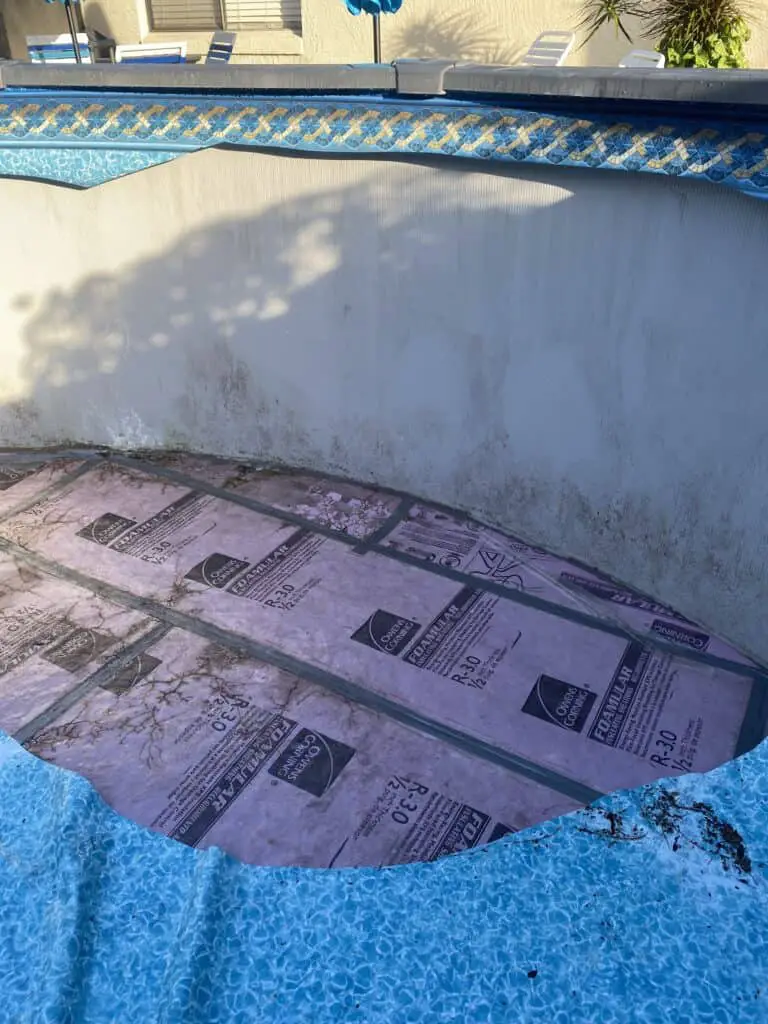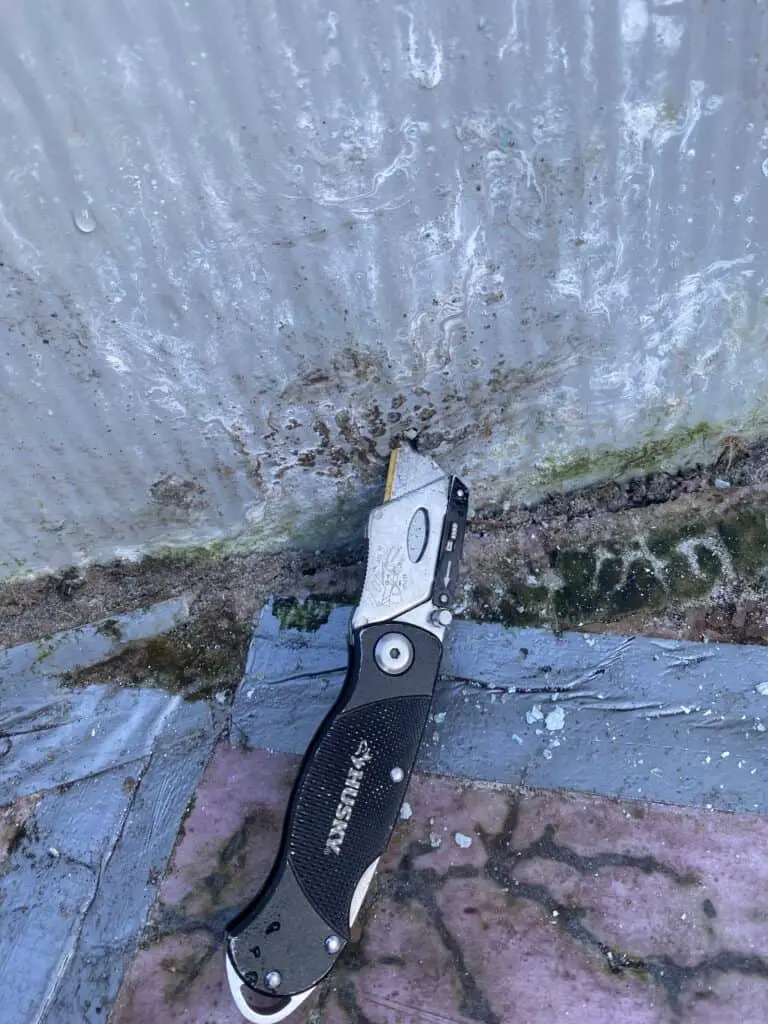When self-installing an above ground swimming pool, people can have varied ideas on what to put down on the ground under the pool. In reality, most pool sites don’t need anything to go down as the liner is designed to sit directly on top of the earth.

Above ground swimming pool liners transfer moisture a lot like a soda or beer can does. This means that moisture underneath the liner has to be able to go into the earth. Materials like Visqueen, tarps, and pearlite can trap moisture and eventually cause the pool’s wall to corrode.
Any material that can trap moisture should not go under a pool liner.

NOTE: This article only applies to metal-walled above ground pools. Soft-sided pool (Intex, Coleman) types have different designs
TRAPPED MOISTURE IS A BIG ENEMY WITH ABOVE GROUND POOLS
A few decades ago, it was a common practice for people to put Visqueen or plastic sheeting down just underneath an above ground pool liner. This would often cause the inside of the wall of the pool to start and eventually rust out.
This is because a vinyl pool liner will transfer moisture or “sweat” moisture through it when there’s a temperature difference.
In a normal situation, the moisture that transfers under the liner will just move away and into the earth and eventually dry or move away from the pool bottom. If something like plastic is placed under the liner though, this moisture can get trapped and have nowhere to go.
Eventually, the moisture will make its way over to where the ground meets the pool wall, and some of it will hang out against the metal wall. If this moisture cannot go anywhere, it will stay next to the pool wall and will soon get past any protective coating the wall has. Once the coating is lifted by the excessive moisture, the metal wall will begin to corrode. This is not at all good.
ONCE METAL BEGINS TO CORRODE, IT DOESN’T STOP
I don’t want to be too scientific here, but I will mention that most things are in a state of either building up or breaking down. This is the main dynamic of everything at least on earth.
When it comes to steel and aluminum (the two metals that above ground pool walls are made of) the rate that they can break down can be greatly increased if there is constant moisture present.
Better quality above ground pool walls are coated to help prevent the beginning of corrosion caused by moisture. This coating can only protect for so long. If the wall is exposed to moisture long enough, then it can penetrate the coating and the metal wall will start corroding.
It’s important to note here that once corrosion begins, it doesn’t stop. You can slow the rate of corrosion down by keeping the metal dry, but it will still be at an elevated rate of breaking down through oxidation.
This is why it’s important to not allow an above ground pool to begin corroding in the first place.
MATERIALS YOU SHOULD NOT PUT UNDERNEATH A POOL LINER
Visqueeen or plastic sheeting
Some will do a great job of completely covering their pool’s bottom with a single piece of plastic. They will even tape the ends to the bottom of the pool wall to help keep it in place for the installing of the liner.
This is a mistake as plastic will trap any moisture from the liner sweating.
Vinyl or poly tarps
These will also disallow moisture from dissipating into the earth. Avoid these.
Note: The less expensive soft-sided Intex/Coleman type of pools come with super cheap tarps that the instructions say to put down just before erecting the pool. This article is not about soft-sided above grounds, They are completely different and you can put down anything you want with them.
The old/existing liner
It’s common for people to want to leave their original liner in the pool and then place the new one on top of it. Yeah, don’t do that.
There are three main reasons not to leave in the old liner. The biggest is the potential for moisture to get trapped (see above). The second is that the old liner may make it hard or impossible to re-smooth the bottom, which is really nice to be able to do during a liner change. The third is that the old liner may cause you to have some wrinkles in your new liner.
Pull that old liner completely out. You’re not gaining anything by leaving it in anyway.
Perlite
More than twenty years ago, a material called “perlite” was commonly used to make bottoms for above ground swimming pools. I installed maybe a couple of dozen pools with this and it wasn’t a bad material to work with other than its fine dust would make you cough.
What I and other professional installers discovered some years later was that, when applied thick and thoroughly, perlite would trap moisture. After seeing a few pools rust out from having a perlite bottom, I stopped endorsing its use.
NOTE: If you must use the above materials for your pool’s bottom for one reason or another, you still can, but you must keep an open space all the way around the bottom or make holes in the material to allow the moisture from sweating to find its way into the earth.
OTHER MATERIALS YOU SHOULDN’T USE UNDER AN ABOVE GROUND POOL LINER
Wood
Occasionally, I will see that someone has put down sheets of plywood under the pool. Then maybe put a layer of sand on top and between it and the liner.
This is not recommended because the wood will eventually breakdown and decompose. And when it does, it will make the pool bottom lumpy and bumpy. Then later, when it’s time to change the liner, it will be a pain to clean out all of that rotted wood and make a nice new pool bottom.
You don’t want to use anything that will quickly decompose in the earth for this reason.
Too much sand
It kills me when I see an above ground pool install manual say that a pool like a 24’ round needs a minimum of 3-4 yards of sand put down. It is true that sometimes this much sand is needed, but in most cases, it’s too much soft material.
In Central Florida (where I install pools), I almost never add sand to a pool bottom. THE REASON – In most yards here, the earth is already mostly sand based. By adding sand to an already soft base will make the bottom too soft and “footprinty”.
Opposite of what most people think, sand doesn’t pack very much. Sand is only made up of aggregate (small grains rock, seashells, minerals), air, and water. You can add water to it and pack it down to help remove the air, but that’s it. It doesn’t pack.
I bring this up because if you have too much sand, you’re more likely to have a bumpier bottom than if you didn’t have as much.
Bad or dirty fill dirt
There have been so many times in my 35 years of installing pools where the homeowner had a truckload of fill dirt dumped in their yard so I can use it for the pool install, but the fill dirt wasn’t clean.
Fill dirt needs to be clean. It can have a bunch of rocks or sticks or construction trash in it. Using dirty fill dirt for an above ground pool is inviting you to have something sharp left under the liner.
NOTE: In almost all cases, a hard base material is NOT needed for installing an above ground pool.
USING FOAM BOARDS TO MAKE A BOTTOM FOR AN ABOVE GROUND POOL

It has become a fairly common practice for people (and some installers) to lay down foam boards under their pools. They will buy as many 4’x8’ sheets of foam. Then duck tape them together to make a smoother and protected pool bottom.
I usually don’t recommend do this. Yep. You heard me right. This is because the foam sheets can trap moisture. After seeing a couple of dozen rusted walls caused by a well-done foam board bottom. I stopped thinking it was a good idea.
If you must use foam boards, you can install them and not cause a moisture barrier. You will just have to have openings that allow moisture to escape into the earth. This is best accomplished by leaving a gap all the way around the pool bottom.
To do this, lay out and tape your foam boards together to a shape smaller than the dimensions of the pool. Afterward, make your pool cove with earth or sand which will cover the gap you have in the boards. This will (hopefully) give room for moisture to escape.
If you are installing a foam board bottom along with foam coving, then you can’t do it this way. You’ll have to make gaps within the pool bottom instead. NOTE: Foam sheeting will NOT prevent nutgrass from growing through the liner.

My question is this: If you install pool floor with a good quality tarp on the ground followed by 2” XPS foam panels ground contact and waterproof rated for under slab application, add vinyl pad( gorilla) and you have good drainage around pool, where is the moisture coming from?
Hi. If you are talking about an Intex/Colman type soft-sided pool, it won’t matter and this article does not apply. For metal-walled pools though, the moisture comes from the vinyl liner (which is explained in fair detail at the beginning of the article). I hope this helps.
The water is condensation. Your pool water temp and ground temperature will be different most of the year. Condensation will form on the outside of the liner and must be able to drain or it will prematurely rust your walls.
Bureau County Pool Builders here. My 24yr career has confirmed that rain and soil in the Midwest is high on the ph scale. All rust we see is caused by Chlorine.
All rust that you see is caused by chlorine? In 24 years, have you seen a rusty bottom track? How about a rusty upright? How about rust in the walls due to a bead receiver/channel? These are just three parts that get rusty often and it’s impossible for it to be chlorine. What 24 year career are you talking about? Are you a cab driver or a engineer or something? lol
I was told by one pool installer that they use what he called “stone dust” at the bottom under the liner. What is your opinion on this? I’m in the Northeast part of the country. Not a great deal of sand in the soil here.
An experienced installer local to you will know your earth well. He/she will know what materials are available and if he needs to add a foreign layer of something. I have used stone dust(the home owner already put down) but it was too rigid to make a good bottom. So in my case, would put down a layer of sand or taped together foam boards on top.
Quick question. I’m having my first above ground pool installed and I’m having pink foam board installed at the bottom of my pool. The base that the pool will be built on is going to be sand. Is there another layer that should be installed between the sand and the pink foam board such as a liner floor pad? Or is the pink foam board essentially the liner floor pad? the reason I’m asking is because I’m buying the pool foam cove to be installed as well and it’s sold with a liner floor pad and without the liner floor pad and I’m wondering whether I should buy it with the liner floor pad. Any advice is greatly appreciated. Thanks!
If putting down foam boards, you don’t need the liner guard(floor pad) at all. This would be an almost total waste of time and money. The only thing a floor pad might give you here is very little added protection from nut grass if it is present. And if you think it is, then spend the floor pad money on a granular nutgrass/sedge killer.
Im trying to be thrifty and I have alot of leftover household tiles and was thought that using tiles as long as I leave like less than 1/8 inch gap so water can still escape into the dirt would that do any damage to my pool liner?
I have never seen tiles used for a pool bottom. My thought is that it wouldn’t work well as they may crack when you walk on them (before the liner goes in) and that they will move off level when walking on them. Unless you mean to place them on a layer of cement, which would be way too big of a job.
And what will be the advantage to doing this? I just don’t see one. Sorry.
So I got my yard leveled 20ft round for my summer waves above ground pool. It doesn’t have the metal walls so can I just install the pool without adding tarp or anything?
You can but might as well put down the cheap one that it comes with.
I have a newly built house and no patio area. Since the goovilla plastic interlocking deck tiles are sustainable and are usable on dirt, would this be a good option for an above ground pool to sit on with the armor shield liner pad in between the two?
I guess so, but why use them at all? Why not just put the pool in the earth? It has to be leveled anyway, so what are you gaining with these plastic tiles?
The person leveling the ground for my pool wanting to use Cardboard boxes underneath, have you heard of this being used ?
I have used cardboard a couple of times several years ago when the ground was too wet and I wanted to get the job done. It won’t hurt anything but I don’t know what you will gain by doing it. Unless you have a lot of sharp debris in the earth.
I am replacing an above ground pool and already have the sand base from the first one. I always thought the bottom was a little soft. The installer said he plans to install another inch or 2 of sand ontop of the old base. According to your article this is going to make the bottom softer than it already is. What are my options here? Does he really need to add more sand?
My feeling is to let the installer do it the way he feels comfortable as you, him, and your pool are dictated by his level of experience.
As an example though, if I were doing your changeout, I wouldn’t add more sand (I very rarely do). I would rebuild the cove for sure (if its made of earth) using the dirt that is already there.
Hi Dan . I have a 15ft metal pool i was thinking about using pad that you put under the flooring it has a moisture barrier it’s about 2mm thick will that work. I really don’t want to get rust on the walls we were using sand n the floor was just getting all these wrinkles when we just removed the liner the padding was all out of wack pulled that up the sand was perfect didn’t understand that?
If it’s a liner guard floor pad made for above ground pools, then yes. If some other product that doesn’t allow moisture to go through it (like plastic), then no.
I have a 12 ×20 kayak pool.with sand that’s been down for about 20 years , can I use like 1 in foam board with foam cove , on floor since it’s mostly aluminum.
You can but aluminum will corrode too, so if you trap moisture, you will have corrosion.
can you put ant killer “over and out” under a pool liner when installing a pool?
Yes as long as it’s not petroleum-based.
We have a 27 foot concrete circle for a pool it is level. We would like to install a hard wall pool that is 20 foot circle. Can we put carpet under the pool to soften up the bottom for our feet. We have a brand new roll of rubber back carpeting.
Yes that should be ok. Don’t forget your foam coving.